(TW and CW: Discussion of genocide)
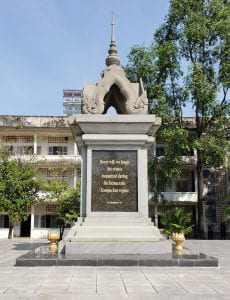 This day started very differently from other days, as we explored one of the most tragic aspects of Cambodia’s complex history: the genocide of 1975-1979. Set during a period of violent civil war, Cambodia’s government was overthrown and replaced by the Khmer Rouge regime, also known as Angkar. In this short period, the leadership of Angkar under Pol Pot sought to transform Cambodia’s society and economy completely, eradicating any sense of past culture or history, and forcing everyone out of the cities and into collective farms where they would be made to work. Anyone expressing connections to the past was punished in one way or another. Simple things such as wearing glasses or being knowledgeable of French could warrant being sent to detention centers and eventually executed. This is the purpose that Tuol Sleng served.
This day started very differently from other days, as we explored one of the most tragic aspects of Cambodia’s complex history: the genocide of 1975-1979. Set during a period of violent civil war, Cambodia’s government was overthrown and replaced by the Khmer Rouge regime, also known as Angkar. In this short period, the leadership of Angkar under Pol Pot sought to transform Cambodia’s society and economy completely, eradicating any sense of past culture or history, and forcing everyone out of the cities and into collective farms where they would be made to work. Anyone expressing connections to the past was punished in one way or another. Simple things such as wearing glasses or being knowledgeable of French could warrant being sent to detention centers and eventually executed. This is the purpose that Tuol Sleng served.
Originally built as a high school in Phnom Penh, Tuol Sleng (officially known as S21) was transformed into a detention center in the newly depopulated city through which tens of thousands of Cambodians would pass and inevitably be killed. That is to say that although the place was intended for interrogation, virtually all who entered would be met with a forced guilty verdict and then systematically executed. We were individually guided through the complex with audio-guides, passing through rooms holding objects of torture and giant photographs and paintings depicting suffering.
It is not alone in its purpose either. Over 100 of these places were set up throughout Cambodia during the Khmer Rouge period, often in temples, schools, or other such locations.
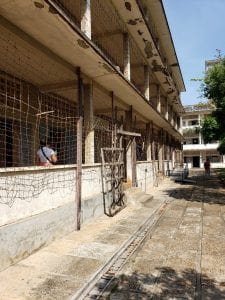 In just 4 years, around a quarter (more than 1.5 million people) of Cambodia’s population died as a result of the Khmer Rouge and its leader (who most Cambodians were never even aware of at the time), Pol Pot. In 1979, the Khmer Rouge was forced out of the government by Vietnam and over the next two decades, it fizzled out in exile in the forest. If this had not occurred, who can say what would have happened to Cambodia.
In just 4 years, around a quarter (more than 1.5 million people) of Cambodia’s population died as a result of the Khmer Rouge and its leader (who most Cambodians were never even aware of at the time), Pol Pot. In 1979, the Khmer Rouge was forced out of the government by Vietnam and over the next two decades, it fizzled out in exile in the forest. If this had not occurred, who can say what would have happened to Cambodia.
Visiting the museum left our group with many different feelings and questions. How can we best remember the people who lost their lives? How can tragic events such as this be prevented? Is leaving this kind of landmark as a way to remember the correct thing to do, or is it disrespectful?
This tragic event transformed Cambodia completely and, in its aftermath, the nation has worked tirelessly to rebuild and revive its culture and society. One way in which this has happened is through the revival of dance. This leads us into the next activity of the day, the dance workshop at SilverBelle Dance Company.
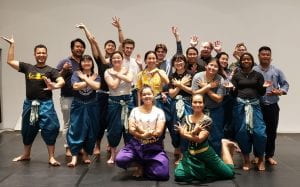 In the dance workshop, we were patiently taught by a group of professional dance instructors three forms of Cambodian dance. First was traditional (focusing on groups), then classical (focusing on characters), and finally contemporary (focusing on the individual).
In the dance workshop, we were patiently taught by a group of professional dance instructors three forms of Cambodian dance. First was traditional (focusing on groups), then classical (focusing on characters), and finally contemporary (focusing on the individual).
It was a lot of fun practicing together with our instructors. First, we had to put on colorful pants made from large rectangular sheets that were tied together by a kroma (Khmer scarf). We then coordinated ourselves into pairs attempting the traditional coconut dance (minus the coconuts). We were generally all over the place, but it was a lot of fun.
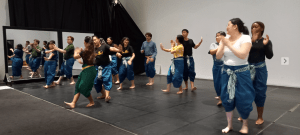 Learning the classical dance was definitely the hardest. Professional classical dancers spend much of their entire lives practicing. Flexibility is a huge part of classical dance and it takes many years to perfect. We had a few hours. The way that gestures were coordinated between hands and feet was very complicated, but Olivia absolutely killed it.
Learning the classical dance was definitely the hardest. Professional classical dancers spend much of their entire lives practicing. Flexibility is a huge part of classical dance and it takes many years to perfect. We had a few hours. The way that gestures were coordinated between hands and feet was very complicated, but Olivia absolutely killed it.
For the final form of dance, contemporary, we integrated aspects of the other forms of dance in a more personalized, individual way. It was less focused on a specific technique and more on creating a personal narrative. We practiced one involving a butterfly and were given free reign in what to do with the butterfly in the last part of the dance. Max decided to swat his poor creature.
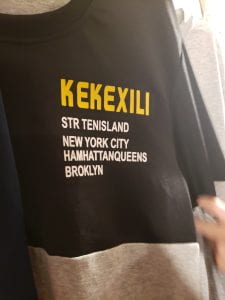 In the evening, a few of us visited the night market and had dinner in preparation for the next day. Max found an amazing shirt showing what were supposed to be the burrows of New York City, though I’m not sure I’ve ever heard of Hamhattanqueens before.
In the evening, a few of us visited the night market and had dinner in preparation for the next day. Max found an amazing shirt showing what were supposed to be the burrows of New York City, though I’m not sure I’ve ever heard of Hamhattanqueens before.